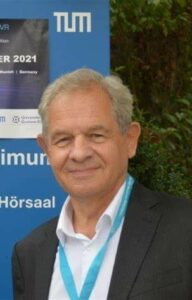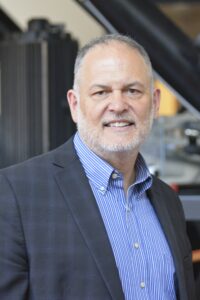Opening Keynote speaker
 Dr. Andras Kemeny
Dr. Andras Kemeny
President and co-founder, Driving Simulation Association, France Member of Board of Directors, ASAM, Germany Conference Chairman
“Augmented Reality and Autonomous Vehicles”
AR is used both for ADAS and Driving Simulation technology, illustrating the convergence of XR, driving simulation and now HUD technologies. This presentation is focusing on the emergence of new on-board AR technology for automotive HUD or AR glasses. It is illustrating the research and technology evolutions discussed all over the Driving Simulation Conferences since the beginning, with the increasing role of XR and AI for driving simulation of ADAS, automated vehicles and human machine interactions.
Invited Keynote speakers
 Ms. Yue Li
Ms. Yue Li
CTO and co-founder, IAE Group, China
“Practice for scenario based simulation accelerating the safe application of autonomous driving”
Car manufactures are exploring commercial implementation scenarios for autonomous driving, hoping to enhance product strength through this technology; Practical and feasible solutions are needed in regulation to form positive guidance and access. In the process of landing for autonomous driving, simulation testing based on a large-scale and systematic scenario library will play a key role in productization and market access. This keynote will focus on sharing the practical experience in China of scenario based L4 autonomous driving simulation testing.

Dr. Behrang Keshavarz
Senior Scientist, KITE Research Institute, UHN, Canada
Adjunct Professor, Toronto Metropolitan University, Canada
“Motion sickness: A challenge in real and simulated driving situations”
Motion sickness affects one in three people, with vomiting, nausea, dizziness, or headache being just few of the many symptoms. Two global mega-trends make motion sickness a major challenge to healthcare and industry in the upcoming decades: fully automated vehicles and Virtual Reality (VR) applications. Motion sickness is a serious concern for both technologies, jeopardizing their success and overall acceptance. In this presentation, Dr. Keshavarz will provide an overview of the phenomenon of motion sickness, with a specific focus on theoretical considerations, factors influencing individual susceptibility, measurement techniques, and potential solutions.

Pr. George Drettakis
Research Director, Inria, France
“The 3D Gaussian Splatting Adventure: Past, Present and Future”
Automobile OEM Keynote speakers

Ms. Tille Karoline Rupp
As automated driving systems become more complex, efficient and robust validation methods are essential. By leveraging simulation, AI, and Big Data, we aim to shorten development and validation cycles, following the left shift principle to detect and resolve issues early.
This keynote highlights the role of automation throughout the entire V-model, ensuring seamless toolchains from development to validation. Standardized, reusable, and consistent data enable Software-in-the-Loop (SiL) and Hardware-in-the-Loop (HiL) testing, as well as driving simulators (Driver-in-the-Loop – DiL), on a shared foundation. In combination with an intelligent test concept, they form the key to efficient validation.

Dr. Joost Venrooij
“Utilizing BMW‘s driving simulation center: virtual development, real challenges”
In 2021, BMW inaugurated the world’s largest driving simulation center, a pivotal element of the company’s virtualization strategy aimed at achieving significant cost reductions in the vehicle development process. Realizing this goal necessitates not only the development of innovative virtualization methodologies and simulation techniques, but also their effective operationalization and utilization. This presentation will provide an exclusive behind-the-scenes perspective on the challenges we faced—and the solutions we implemented—in bringing BMW’s driving simulation center to life. It will outline how advancements in vehicle modeling methods, motion cueing techniques, validation approaches, and some practical lessons learned, were brought together to make virtual vehicle development a reality.

Dr. Richard Romano
Staff Researcher, General Motors, United States
Visiting Professor, University of Leeds, United Kingdom
“Human Centered Vehicle Design in the Age of Agile Software Development: The role of driving simulators”
Industrial Keynotes speakers

Dr. Craig Brown
“ProCue: Outcue the Competition”
 Prof. Bernhard Schick
Prof. Bernhard Schick
CEO, MdynamiX and Head of Institute for Driving Assistance and Connected Mobility (IFM), University of Applied Sciences Kempten
“Hardware-in-the-Loop for Enhancing Steering Experience in Driving Simulators”
Test drives are expensive, time-consuming, and often difficult to implement, yet they provide essential insights. The goal is to shift more development into simulations and reduce the number of prototypes, but virtual approaches reach their limits when subjective evaluations are crucial. Driving simulators can help bridge this gap — provided they realistically replicate the driving feel. In particular, authentic steering feel is key to high-quality assessments for almost all relevant use-cases, but is difficult to simulate purely virtually. This presentation introduces MdynamiX’s Hardware-in-the-Loop (HiL) solutions, which integrate e.g. real steering systems into simulators, enabling a new level of driving realism and evaluation quality, including high-frequency dynamics and road surface contact. It is complemented by insights from participant and expert studies, concrete development use cases, and highlights further potential for new applications.

Dr. Henrik Gommel
“Bridging the Virtual–Real Continuum: Driving Simulation as an Enabler for HMI Development”
Modern HMI systems demand both engineering precision and customer-centric validation. GOTECH GmbH’s VR-based driving simulator meets this need by seamlessly merging real hardware mockups – whether purely haptic or fully functional – with virtual representations and conceptual functions.
This flexible continuum allows engineers and end users alike to configure, test, and refine display and control elements with agility. By incorporating simulated traffic and real critical scenarios in a safe environment, the simulator becomes the enabler of fast, efficient, and highly realistic development and evaluation.